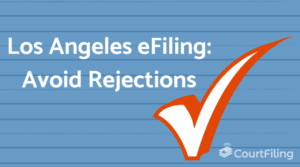
The Los Angeles Supreme Court recently listed some potential reasons for court filings rejections to help you prepare and review your paperwork while eFiling. Avoiding rejections saves you time and money so that your case can continue as scheduled. To help ensure that everything is correct, review these common rejection reasons:
The county clerk oftentimes includes notes hinting at the reason(s) why the paperwork was rejected so that you can correct the issue. However, it is best to not have your paperwork rejected at all. Therefore, we have outlined a few steps to help ensure that your paperwork is correctly filed the first time.
eFiling your paperwork correctly saves you time and money. In addition to this help article, we recommend scouring your paperwork, the Los Angeles rules, and any additional help guides so your paperwork has the best chance of being accepted.
Bearing the “rejection reasons” list above, you should always make sure that your case number, location, category, and type are consistent and match your case information. In order for the court to properly store and organize your paperwork, the correct case and information must be consistent across all your paperwork for a single case.
In line with consistency, be sure that you have the correct case number on your paperwork. Initial court filings typically do not have a case number as it is the first paperwork submitted and no number is yet assigned. However, subsequently filing on an existing case requires you to input the correct case number. Case numbers are often found on the top right of existing paperwork. When uploading new documents, be sure that your case number matches the same format as found on previous documents.
Your case type defines the procedures and paperwork required and is therefore important to label correctly. Do your due diligence and research what type of case you are filing or contact a lawyer for further guidance. Once your case type is known, be sure that you select the correct type on all your filings.
While it may seem obvious, be sure that you are filing in the correct court where your case is being heard and processed. If you are unsure of your court location, call the courthouse with your case number and see if they have any information that can direct you to the correct court location.
Selecting to correct document type is extremely important. There are various forms and documents that accompany case types, and each have their own requirements. The document type allows the court to properly assess and collect the information they need to categorize and organize cases. If you choose the wrong document type, your paperwork will be rejected.
After ensuring that you select the correct document type, be sure that you are uploading the corresponding files for that document type. The selected document type and the files you are uploading must match.
It is required that some documents are filed “under seal” or confidentially. Other documents simply need important information (like social security numbers) redacted. Be sure that your paperwork follows the standards for confidential or under seal consideration and approval. For instance, to file paperwork as confidential, you will need authorization from the court. If you file confidential or under seal paperwork, be sure to include the paperwork authorizing such restrictions.
Oftentimes, scanning documents containing signatures of opposing parties instead of using electronic signatures is required. If you are submitting paperwork with opposing party signatures, be sure to scan said document so that the signatures are legitimate.
When filing your paperwork, appropriately select what type of party you are, as well as the opposing side. Some types of parties include:
Consistency plays another role in party information. Be sure the party names are accurate and match previous files. This allows the court certainty that the parties remain unchanged, as well as the ability to keep track of those involved and potentially keep similar names separate and clear.
As with party names, keep addresses consistent so that the court is sure that additional parties are not being added to the case. It also ensures that the correct person receives the case information. Refer back to previous case documents for the correct addresses.
Need more information on how to eFile? Read our Los Angeles eFiling Guide:
Share This Post
Support ArticlesFind answers in our extensive directory of help articles. |
|
Live ChatOur most popular support option. Connect with us right away. |
|
(801) 448-7268Call us Monday through Friday between the hours of 7:00 AM to 7:00 PM PST. |